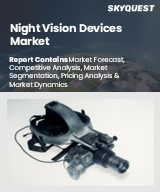
세계의 야시장비 시장 규모는 2023년 82억 달러로 평가되었고, 예측 기간인 2025-2032년 CAGR 9.1%로 성장할 전망이며, 2024년 89억 5,000만 달러에서 2032년까지는 179억 6,000만 달러로 성장할 전망입니다.
세계의 야시장비 시장은 이미징 센서 기술, 특히 적외선(IR) 및 서멀 이미징의 진보로 큰 성장을 이루고 있습니다. 이러한 기술 혁신에 의해 화상의 선명도, 검출 범위, 저조도 감도가 향상되어 완전한 어둠에서도 야시장비의 효과가 높아집니다. 센서의 효율이 향상됨에 따라 비용이 낮아져 소비자나 산업계에서 이러한 기기가 보다 친숙해집니다. 군사 및 방위 분야는, 안전 보장상의 염려 및 지정학적 긴장의 고조에 의해, 야간 작전용 고도의 기술이 필요하기 때문에, 이 수요의 현저한 견인역이 되고 있습니다. 강화된 열 및 IR 기능을 통해 군대는 상황 인식을 향상시키고 시야가 나쁜 시나리오에서도 효과적으로 대응할 수 있게 됩니다. 그 결과 방위 예산이 증가하고 장비 업그레이드가 진행됨에 따라 야시장비 수요는 크게 증가할 것으로 예상됩니다.
Global Night Vision Devices Market size was valued at USD 8.2 billion in 2023 and is poised to grow from USD 8.95 billion in 2024 to USD 17.96 billion by 2032, growing at a CAGR of 9.1% during the forecast period (2025-2032).
The global night vision devices market is experiencing significant growth due to advancements in imaging sensor technologies, particularly in infrared (IR) and thermal imaging. These innovations enhance image clarity, detection range, and low-light sensitivity, making night vision equipment more effective even in complete darkness. As sensor efficiency improves, costs decrease, making these devices more accessible for consumers and industries. The military and defense sectors are notable drivers of this demand, as rising security concerns and geopolitical tensions necessitate advanced technology for nighttime operations. Enhanced thermal and IR capabilities allow armed forces to improve situational awareness and respond effectively in low-visibility scenarios. Consequently, as defense budgets increase and equipment upgrades continue, the demand for night vision devices is expected to rise significantly.
Top-down and bottom-up approaches were used to estimate and validate the size of the Global Night Vision Devices market and to estimate the size of various other dependent submarkets. The research methodology used to estimate the market size includes the following details: The key players in the market were identified through secondary research, and their market shares in the respective regions were determined through primary and secondary research. This entire procedure includes the study of the annual and financial reports of the top market players and extensive interviews for key insights from industry leaders such as CEOs, VPs, directors, and marketing executives. All percentage shares split, and breakdowns were determined using secondary sources and verified through Primary sources. All possible parameters that affect the markets covered in this research study have been accounted for, viewed in extensive detail, verified through primary research, and analyzed to get the final quantitative and qualitative data.
Global Night Vision Devices Market Segments Analysis
Global Night Vision Devices Market is segmented by Device Type, Technology, Mounting Type, Application and region. Based on Device Type, the market is segmented into Cameras, Goggles, Scopes and Binoculars & Monoculars. Based on Technology, the market is segmented into Image Intensification, Thermal Imaging, Infrared Illumination and Digital Imaging. Based on Mounting Type, the market is segmented into Stationary and Portable. Based on Application, the market is segmented into Law Enforcement, Commercial Surveillance, Navigation, Wildlife Surveillance and Other Applications. Based on region, the market is segmented into North America, Europe, Asia Pacific, Latin America and Middle East & Africa.
Driver of the Global Night Vision Devices Market
The global night vision devices market is predominantly driven by escalating defense budgets in nations such as the United States, China, and India. These governments are investing heavily in advanced surveillance and security technology to enhance military preparedness and operational effectiveness during nighttime or low-light missions. This increased military expenditure is significantly contributing to the expansion of the market, as countries prioritize state-of-the-art equipment to ensure optimal performance and security. Consequently, the demand for night vision devices is surging, reflecting a crucial trend in the defense sector aimed at improving capabilities in various operational circumstances.
Restraints in the Global Night Vision Devices Market
Despite innovations in night vision technology, one significant obstacle is the restricted battery life of these devices. This limitation poses challenges for users, especially in military and surveillance scenarios, where prolonged operational capability is essential. The relatively short duration that night vision devices can function before requiring a recharge or battery replacement may hinder their widespread adoption. Consequently, the dependence on frequent recharging or battery swaps can discourage potential users, ultimately affecting the overall growth and acceptance of night vision systems in the global market. Addressing these battery life concerns is crucial for enhancing user experience and expanding market reach.
Market Trends of the Global Night Vision Devices Market
The global night vision devices market is witnessing a significant trend towards the integration of artificial intelligence, which is revolutionizing the sector by enhancing night vision capabilities. AI algorithms are increasingly utilized to improve image quality, facilitate precise target identification, and adapt to various environmental conditions in real-time. This technological advancement not only elevates the efficacy of night vision devices for military applications but also broadens their appeal in commercial markets, including security and wildlife observation. As a result, the demand for sophisticated, AI-powered night vision technologies is projected to surge, indicating a promising growth trajectory for the industry in the coming years.